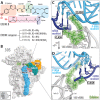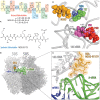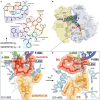The Mechanisms of Action of Ribosome-Targeting Peptide Antibiotics
- PMID: 29868608
- PMCID: PMC5960728
- DOI: 10.3389/fmolb.2018.00048
The Mechanisms of Action of Ribosome-Targeting Peptide Antibiotics
Abstract
The ribosome is one of the major targets in the cell for clinically used antibiotics. However, the increase in multidrug resistant bacteria is rapidly reducing the effectiveness of our current arsenal of ribosome-targeting antibiotics, highlighting the need for the discovery of compounds with new scaffolds that bind to novel sites on the ribosome. One possible avenue for the development of new antimicrobial agents is by characterization and optimization of ribosome-targeting peptide antibiotics. Biochemical and structural data on ribosome-targeting peptide antibiotics illustrates the large diversity of scaffolds, binding interactions with the ribosome as well as mechanism of action to inhibit translation. The availability of high-resolution structures of ribosomes in complex with peptide antibiotics opens the way to structure-based design of these compounds as novel antimicrobial agents.
Keywords: antibiotic; inhibitor; proline-rich antimicrobial peptides; ribosome; translation.
Figures











Similar articles
-
ITC Studies of Ribosome/Antibiotics Interactions.Methods Mol Biol. 2019;1964:89-98. doi: 10.1007/978-1-4939-9179-2_7. Methods Mol Biol. 2019. PMID: 30929237
-
Blast from the Past: Reassessing Forgotten Translation Inhibitors, Antibiotic Selectivity, and Resistance Mechanisms to Aid Drug Development.Mol Cell. 2016 Jan 7;61(1):3-14. doi: 10.1016/j.molcel.2015.10.019. Epub 2015 Nov 12. Mol Cell. 2016. PMID: 26585390 Review.
-
The proline-rich antimicrobial peptide Onc112 inhibits translation by blocking and destabilizing the initiation complex.Nat Struct Mol Biol. 2015 Jun;22(6):470-5. doi: 10.1038/nsmb.3034. Epub 2015 May 18. Nat Struct Mol Biol. 2015. PMID: 25984971
-
Structures of the orthosomycin antibiotics avilamycin and evernimicin in complex with the bacterial 70S ribosome.Proc Natl Acad Sci U S A. 2016 Jul 5;113(27):7527-32. doi: 10.1073/pnas.1604790113. Epub 2016 Jun 21. Proc Natl Acad Sci U S A. 2016. PMID: 27330110 Free PMC article.
-
Using the Bacterial Ribosome as a Discovery Platform for Peptide-Based Antibiotics.Biochemistry. 2019 Jan 15;58(2):75-84. doi: 10.1021/acs.biochem.8b00927. Epub 2018 Nov 8. Biochemistry. 2019. PMID: 30372045 Free PMC article. Review.
Cited by
-
The Effects of Different Antimicrobial Peptides (A-11 and AP19) on Isolated Bacteria from Fresh Boar Semen and Semen Quality during Storage at 18 °C.Antibiotics (Basel). 2024 May 24;13(6):489. doi: 10.3390/antibiotics13060489. Antibiotics (Basel). 2024. PMID: 38927156 Free PMC article.
-
Antimicrobial Activities of Salacia oblonga Wall Leaf and Root Extracts Against Different Bacterial Strains and Fungal Isolates.Curr Microbiol. 2022 May 25;79(7):204. doi: 10.1007/s00284-022-02888-4. Curr Microbiol. 2022. PMID: 35612657
-
Oxydifficidin, a potent Neisseria gonorrhoeae antibiotic due to DedA assisted uptake and ribosomal protein RplL sensitivity.bioRxiv [Preprint]. 2024 Sep 25:2024.05.27.596031. doi: 10.1101/2024.05.27.596031. bioRxiv. 2024. Update in: Elife. 2025 May 28;13:RP99281. doi: 10.7554/eLife.99281. PMID: 38854004 Free PMC article. Updated. Preprint.
-
Triphenylphosphonium Analogs of Short Peptide Related to Bactenecin 7 and Oncocin 112 as Antimicrobial Agents.Pharmaceutics. 2024 Jan 22;16(1):148. doi: 10.3390/pharmaceutics16010148. Pharmaceutics. 2024. PMID: 38276518 Free PMC article.
-
Antimicrobial Peptides: Bringing Solution to the Rising Threats of Antimicrobial Resistance in Livestock.Front Vet Sci. 2022 Apr 8;9:851052. doi: 10.3389/fvets.2022.851052. eCollection 2022. Front Vet Sci. 2022. PMID: 35464355 Free PMC article. Review.
References
-
- Aminake M. N., Schoof S., Sologub L., Leubner M., Kirschner M., Arndt H. D., et al. . (2011). Thiostrepton and derivatives exhibit antimalarial and gametocytocidal activity by dually targeting parasite proteasome and apicoplast. Antimicrob. Agents Chemother. 55, 1338–1348. 10.1128/AAC.01096-10 - DOI - PMC - PubMed
Publication types
LinkOut - more resources
Full Text Sources
Other Literature Sources

